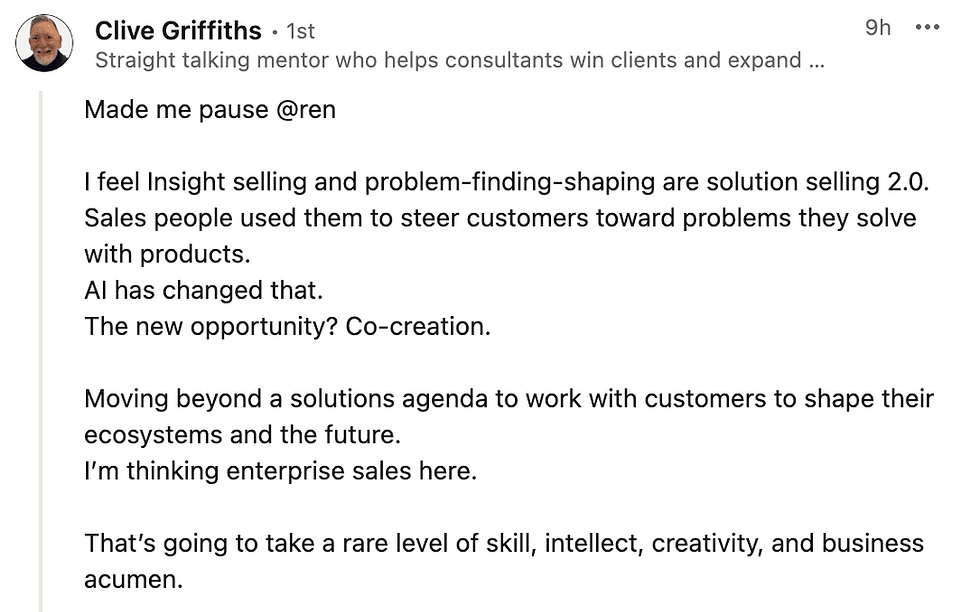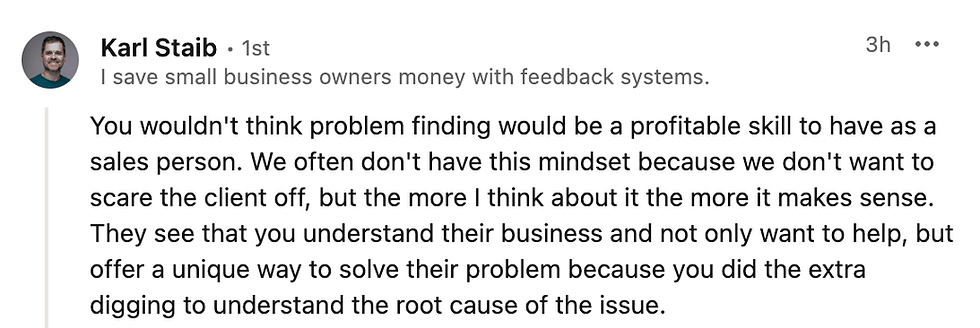Move beyond solution selling
- Ren Saguil

- Feb 15
- 3 min read
I have been talking with AI Google Studio a lot lately.
I am mind-blown everyday not only with the capabilities of Gen AI but the speed of how they improve every week.
And it hit me.
The superpower of a salesperson has evolved.
It’s no longer about solving our client's problems.
Today's buyers are so smart. They are highly informed, with so much information. They have Google, ChatGPT, Claude and so many new AI apps launching everyday. They have access to industry reports, and peer networks at their fingertips.
If they know their problem, they're probably already halfway to finding a solution without us.
But here's where it gets interesting...
The real gold mine? It's in problem-finding.
Let me explain.
I'm seeing this pattern more and more: prospects come to us thinking they know their problem, but they're often just seeing the symptoms. Or sometimes, they're so deep in their day-to-day that they're completely blind to major issues heading their way.
When you help clients think differently and see the real problem and impact to their business—that's when the magic happens.
This is where we, as elite sales professionals, need to step up our game.
Problem-finding is our new edge, and it's a whole different skillset from problem-solving.
I shared this insight on LinkedIn and received some powerful feedback, which I'm sharing here.
I love Clive's insight on co-creating, for me it's an opportunity for elite sales people to create premium jobs. We called it Sales 3.2!

And Karl's point about offering unique insights to our clients.

I appreciate Naty's insight on customer experience: helping clients discover the right problem first. Often, they can't see it clearly because they're too close to the situation.

So how do we drive these conversations?
How do we become "problem-finders"?
The 5-Step Problem-Finding Framework:
1.Resist the Solution Rush Don't jump straight into pitching solutions
(I know, it's tempting!). Instead, get curious about what's beneath the surface. When a client says they need a new CRM, ask what's driving that need. You might discover their real issue is customer churn, not software. Or worse, the sales team not using the software at all. That means you'll waste months pursuing an opportunity that isn't real.
2. Guide Their Sense-Making
Help them connect dots they might not see. Use divergent thinking – explore multiple angles, challenge assumptions. I recently had a client who thought they needed more sales training, but through this process, we uncovered their real issue was their sales process didn't match their buyers' journey.
3. Priority Mapping
Not all problems are created equal. Work with them to rank issues based on business impact and urgency. This isn't just about making a list – it's about helping them see which problems, if solved, would create a cascading positive effect.
4. Impact Quantification
Get specific about the cost of inaction. Help them gather evidence and put numbers to the pain points. What's the revenue impact? The operational cost? The opportunity cost?
5. Context Analysis
Understand their constraints – budget, time, resources, politics. A brilliant solution that can't be implemented is no solution at all.
Here's the real game-changer: this approach isn't just about solving today's problems. It's about helping clients see around corners and prepare for what's coming.
Quick Action for you: In your next discovery call, try this: Instead of asking "What problems are you trying to solve?" ask "What changes in your industry are impacting your business most significantly?" Notice how different the conversation becomes.
I'd love to hear your experiences with problem-finding. What techniques have worked for you? What challenges are you facing?
Hit reply and let me know – I read every response.
Until next week, Ren
P.S. If you found this valuable, share it with a colleague who might benefit from leveling up their discovery skills.



Comments